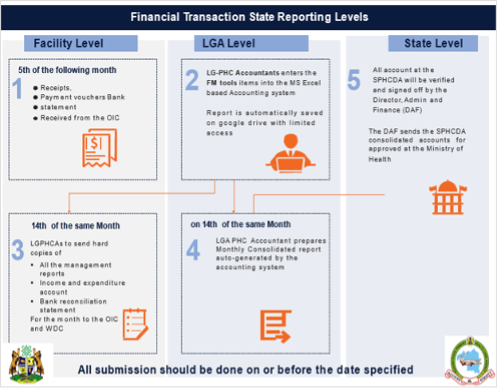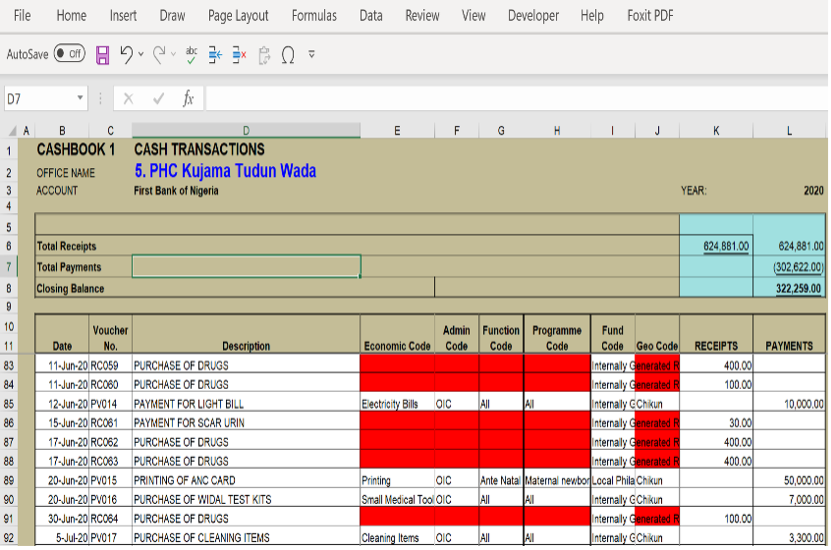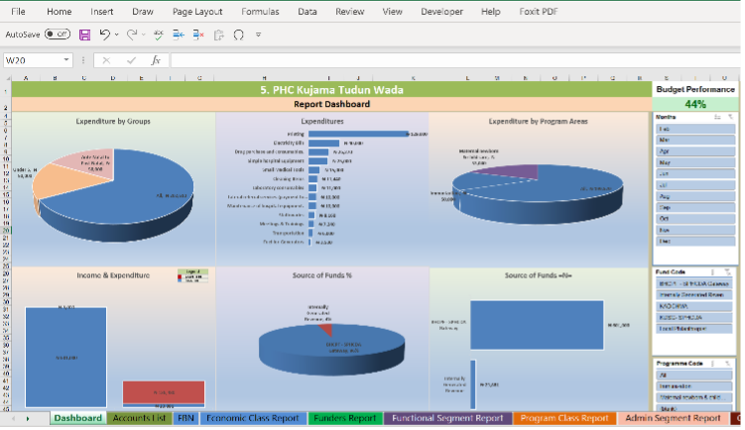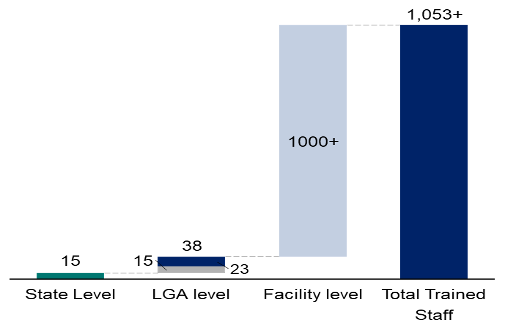Leçons tirées de la mise en œuvre des réformes de la gestion des finances publiques dans les centres de soins primaires de l'État de Kaduna (PHCs)
Contexte (pourquoi la gestion des finances publiques est importante)
Le terme "GFP" est un concept large généralement utilisé pour décrire la manière dont les gouvernements gèrent les ressources publiques, y compris les systèmes de préparation, d'approbation, d'exécution et d'évaluation du budget. Un bon système de GFP améliore l'efficacité et la transparence du processus budgétaire, ce qui conduit à une gouvernance responsable et réactive et à une augmentation des dépenses publiques.
Dans l'ensemble, les études ont montré qu'une budgétisation précise augmente les allocations de fonds vers différents secteurs, y compris la santé, en particulier dans les pays où la transparence budgétaire est plus grande et la corruption moins importante. Dans certains cas, l'amélioration du processus budgétaire s'est traduite par de meilleurs résultats en matière de santé, notamment des taux de mortalité infantile plus faibles et des taux d'utilisation des soins de santé plus élevés.
À Kaduna, le secteur de la santé est déterminé à développer son système de gestion des finances publiques afin de garantir que des allocations de ressources et des processus budgétaires adéquats contribuent au fonctionnement des SSP, ce qui se traduit par des services plus fiables et de meilleure qualité.
Les diagnostics des soins de santé primaires de Kaduna menés par le HSDF en 2015 ont révélé un manque de transparence concernant les flux de ressources vers les établissements, en raison de l'absence de demande de données financières, d'outils de reporting non standardisés et d'une faible capacité à établir des rapports financiers dans l'État. Sur une période de cinq ans, les parties prenantes à tous les niveaux du gouvernement de l'État, à savoir le ministère de la santé de l'État de Kaduna (KSMoH), le conseil des soins de santé primaires de l'État de Kaduna (KSPHCB), l'agence des soins de santé primaires des gouvernements locaux (LGPHCA), le ministère des finances (MoF), l'autorité de gestion de la santé contributive de l'État de Kaduna (KADCHMA) et l'agence de gestion des fournitures de santé de l'État de Kaduna (KADHSMA), ont été impliquées dans le processus. Un module d'intervention a été développé dans le but d'améliorer la faisabilité de la budgétisation et de l'allocation des soins de santé au niveau des SSP et a été validé par tous les ministères, départements et agences (MDA).
En février 2020, 255 centres de soins de Kaduna ont commencé à établir des rapports en utilisant le système de comptabilité en nuage développé avec la supervision et l'aide du HSDF. Cela a permis d'améliorer la transparence du financement des soins de santé primaires - revenus, allocations, dépenses et recettes internes moyennes générées par les soins de santé primaires (IGR) - fournissant ainsi des informations importantes pour une prise de décision de qualité.
Cette note détaille l'intervention de gestion financière mise en œuvre à Kaduna, les défis rencontrés au cours de la première année de mise en œuvre et les leçons tirées jusqu'à présent. Nous espérons que cela aidera les responsables politiques et les décideurs, ainsi que les autres partenaires de mise en œuvre, dans leur approche de la mise en œuvre d'interventions visant à améliorer la prestation de services de soins de santé.
Processus de mise en œuvre
Processus de mise en œuvre des principales interventions en matière de gestion des finances publiques (GFP) soutenues par le HSDF.
- Évaluation de base : Une évaluation de base de la GFP a été menée dans 168 établissements (un échantillon des 255 établissements focaux de Kaduna) au premier trimestre 2019 sur les pratiques de gestion financière. Cette évaluation a révélé un manque de politiques définies pour aborder tous les domaines de la gestion financière, une mauvaise coordination et des compétences en matière de gestion financière (FM) à la fois au niveau de l'État et de l'établissement. Les recommandations de l'évaluation ont permis d'établir une liste de mesures correctives qui ont guidé la conception d'un système de gestion financière réformé dans quatre domaines thématiques : les politiques, les contrôles, les processus et la gestion financière. quatre domaines thématiques : les politiques, les contrôles, les processus et les rapports dans les SSP. Ces domaines thématiques ont été utilisés pour concevoir des interventions de GFP dans l'État de Kaduna.
- Système de PFM défini : Un manuel de PFM qui aborde processus, contrôles et politiques pour guider le système de gestion des finances publiques des soins de santé primaires. Le manuel comprend :
- A un cadre de gouvernance conçu qui prend en considération les acteurs clés de l'État à tous les niveaux pour une gestion efficace, l'inclusion et l'équilibre des pouvoirs.
- Les structures de rapport pour assurer la responsabilité et la transparence à tous les niveaux du gouvernement, visant à améliorer les soins de santé primaires.
- Une norme détaillée de fonctionnement de tous les processus de gestion des finances publiques à tous les niveaux.
L'implication de la communauté dans le développement des soins de santé avec l'utilisation des membres du comité de développement de quartier (Ward Development Committee - WDC) en tant que cosignataires des comptes des SSP pour s'aligner sur d'autres interventions de l'État dans le cadre du FM et renforcer la gouvernance locale au niveau de la communauté. Cela devrait servir de contrôle pour les responsables des SSP.

- Outils de GFP définis: An Système comptable basé sur Excel a été mis au point pour permettre une déclaration précise des transactions financières conformément à la classification des fonds selon les normes comptables internationales du secteur public (IPSAS). Les normes IPSAS sont des normes internationales de reporting des transactions financières qui fournissent des détails supplémentaires sur les fonds dépensés. HSDF a développé :
- Un système comptable qui présente un livre de caisse en utilisant six classifications IPSAS pour enregistrer les transactions financières par rapport aux activités et générer des preuves pour les rapports financiers à des fins d'audit. Le système comptable génère automatiquement des rapports financiers par bailleur de fonds, segment économique, segment fonctionnel, segment de programme, segment administratif et segment géographique.
- Un tableau de bord visuel qui affiche toutes les recettes et dépenses totales, les bailleurs de fonds et les dépenses par domaine de programme de maladie et sous-groupe de programme. Le tableau de bord est disponible au niveau de l'établissement, de l'AGL et de la zone.
- Un modèle de rapport utilisé pour créer le rapport financier mensuel des SSP pour les réunions de gestion de l'État. Cela signifie que pour chaque argent dépensé dans les SSP, le rapport indique :
- ce à quoi l'argent a été dépensé
- qui a autorisé la dépense
- qui ou quelle organisation a fourni l'argent
- à quel(s) programme(s) ou service(s) de soins de santé l'argent a été utilisé
- quel sous-groupe de la population a bénéficié de l'argent dépensé
- où l'argent a été dépensé (lieu)


- Renforcement des capacités : Formation et renforcement des capacités de l'ensemble du personnel de l'État impliqués dans le processus de gestion financière. Plus précisément, le FDSS a formé :
- Environ 1000 personnes + le personnel de l'établissement et de la communauté, y compris les responsables de l'établissement, les responsables adjoints, les présidents et les trésoriers des comités de développement de quartier (CDR) de la communauté.
- 23 comptables des soins de santé primaires du gouvernement local (LGPHCA) et 15 comptables adjoints du LGPHCA (toutes les AGL n'ont pas de comptables adjoints) sur la présentation des données financières sur papier soumises par les CAO dans le système comptable basé sur Excel.
- Une quinzaine d'employés au niveau de l'État ont reçu une formation sur le manuel de gestion financière et le modèle de rapport. Ce personnel a également été formé en tant que formateurs pour servir de champions du FM et de mentors dans l'État de Kaduna.
- Tous les membres du personnel du département de la comptabilité de l'État et de l'AGL sont formés à Excel et à l'utilisation de Google Drive comme mode de rapport en ligne pour les données en temps réel.

- Guide de l'outil de déploiement de la PFM: Développement et fourniture de services de gestion financière des guides d'outils "comment faire" pour les OCI afin de permettre l'établissement des rapports financiers dans les délais et avec précision.
- Des guides ont été élaborés sur la manière de remplir les outils du manuel de gestion des soins de santé primaires - reçus, bons de paiement, modèle de budget et détails sur les niveaux de rapport et les délais.
Tous les guides pratiques ont été rassemblés sur un tableau à feuilles mobiles et les principaux guides ont été présentés sous forme d'affiches, qui ont été remises à chaque établissement afin d'aider les CPO à remplir les formulaires.


Défis de la mise en œuvre
- Système de gestion des finances publiques défini
- Il n'y a pas de structure hiérarchique directe entre les LGPHCA et les SPHCB dans l'État de Kaduna ( ). Les LGPHCA sont responsables du suivi et de l'encadrement des OCI, mais le personnel des LGPHCA relève du ministère de l'administration locale et non de la SPHCB. Cela a affecté la gestion et la synergie ainsi que la capacité des LGPHCA à s'acquitter efficacement de leurs tâches.
- Le manque de communication entre les autres organismes parapublics de soins de santé impliqués dans le financement des SSP. Les SSP de Kaduna reçoivent actuellement des fonds du BHCPF, de la KADCHMA et de l'autorité du LGA. Cependant, le SPHCB ou le LGPHCA ne sont parfois pas au courant du déboursement, ce qui empêche les comptables du LGPHC de suivre et de contrôler correctement les rapports financiers des SSP.
- Outils de GFP définis
- Disponibilité en temps voulu des outils de gestion financière dans les SSP. Les SSP ont connu des ruptures de stock de certains outils de gestion financière - les bons de réception et les bons de paiement. Le manque d'outils en juillet et en août a entraîné une baisse du taux de déclaration. L'État doit éviter cette situation en veillant à ce que tous les outils FM soient imprimés à temps. L'État peut également approuver l'utilisation des fonds du BHCPF pour imprimer les outils dans chaque établissement.
- Renforcement des capacités
- Faible capacité et engagement du personnel du SPHCB à gérer le suivi du processus. Il n'y avait que cinq employés du SPHCB dans le service de comptabilité, ce qui rendait difficile le transfert de l'intervention au personnel du SPHCB. L'État doit recruter davantage de personnel pour contrôler la disponibilité et la qualité des données fournies par les établissements. Bien que le personnel du SPHCB ait été formé à l'utilisation de ces guides, il ne s'est pas engagé à suivre le processus de FM.
- Faible taux de déclaration et problèmes de qualité des données.
Cinq AGL n'ont pas fait de rapport pendant toute la durée de l'intervention et environ trois AGL ont cessé de faire des rapports quelques mois plus tard. Ces comptables d'AGL devaient être remplacés, mais les nouveaux comptables auraient besoin d'un certain niveau de mentorat et de coaching pour guider la supervision des installations, ce qui pourrait inclure l'établissement de nouvelles relations avec les CAO des installations. Les comptables du GL doivent encore améliorer le suivi des établissements et la qualité des rapports. Les comptables du GL et le personnel des SSP ont besoin d'une surveillance et d'une rétroaction constantes pour s'améliorer.
Enseignements tirés
D'une manière générale, les principales observations relatives à la mise en œuvre de la gestion financière, du niveau de l'État à celui des établissements, qui ont eu des répercussions sur la qualité des interventions, peuvent être regroupées en cinq catégories :
- Une communication adéquate lors de l'engagement initial des parties prenantes
Il est essentiel pour la mise en œuvre d'obtenir l'adhésion des principales parties prenantes de l'État. Les connaissances de base de l'équipe et sa compréhension du style de gouvernance de l'État de Kaduna ont permis de planifier la méthode la plus efficace pour communiquer avec toutes les parties prenantes clés à tous les niveaux du gouvernement.
- Encourager l'engagement des parties prenantes de l'État et leur adhésion aux objectifs de l'intervention. L'appropriation totale des interventions a facilité la mise en œuvre. Il était important que l'équipe du HSDF s'aligne sur les membres du SPHCB pour s'engager pleinement dans la conception des politiques et des processus de gestion financière dans l'État. Nous avons également consulté les ministères, départements et agences (MDA) impliqués dans les soins de santé, tels que le ministère des Finances (MoF), l'autorité de gestion de la santé contributive de l'État de Kaduna (KADCHMA) et l'agence de gestion des fournitures de santé de l'État de Kaduna (KADHSMA), qui sont impliqués dans le financement des soins de santé primaires. Tous les résultats finaux ont été validés par l'ensemble des ministères de la santé et des organismes parapublics de Kaduna.
- Minimiser les changements en s'appuyant sur les structures existantes. Nous avons essayé de minimiser le niveau de changement au sein des structures existantes de l'État, c'est pourquoi nous nous sommes inspirés de certains processus FM de l'État de Kaduna. Pour les structures de reporting FM, nous avons inclus les comptables des SSP de l'AGL, car ils étaient censés assurer la supervision des SSP. Nous avons également conservé les outils de gestion financière existants afin de garantir l'uniformité dans tous les organismes parapublics. Dans l'ensemble, il a été plus facile pour les SSP de s'adapter au système.
- Se concentrer davantage sur le soutien au changement de comportement du personnel lors de la transition vers les nouvelles procédures. Le maintien de la mise en œuvre des interventions de GFP nécessite un engagement fort et un changement de comportement de la part du personnel. Il est donc important de former le personnel à ses nouvelles compétences et responsabilités et de lui faire comprendre l'impact des nouveaux apprentissages sur son développement personnel. En outre, des stratégies visant à motiver et à récompenser le personnel pendant cette période de transition peuvent être nécessaires pour obtenir un meilleur engagement de la part du personnel. Les résultats de ces stratégies seraient des membres du personnel compétents et dévoués qui pourraient servir de formateurs à d'autres membres du personnel et à des recrues dans l'État.
- Évaluation continue des interventions. L'évaluation des interventions mises en œuvre permet de mesurer le succès et de prendre en compte le retour d'information et l'amélioration. Pour mesurer le succès des interventions en matière de gestion des finances publiques dans l'État de Kaduna, nous avons créé des critères et des mesures d'évaluation qui font l'objet d'un suivi permanent. Ces mécanismes d'amélioration et de retour d'information sont constamment développés pour améliorer le système de gestion des finances publiques.
Référence
- Données HSDF Shugabanci
- OMS (2018) " Building strong public financial management systems towards universal health coverage : key bottlenecks and lessons learnt from country reforms in Africa " projet de rapport technique de base atelier régional sur la gestion des finances publiques pour un financement durable de la santé en Afrique ; 25-28 septembre - Nairobi, Kenya. Disponible : https://www.who.int/health_financing/events/pfm-for-health-in-africa.pdf
Spécialiste des subventions et du développement des entreprises
Nous sommes à la recherche d'un spécialiste des subventions et du développement commercial très motivé et expérimenté pour rejoindre notre organisation. Le candidat retenu sera chargé d'identifier les possibilités de financement, d'élaborer des propositions de subventions et de favoriser les partenariats avec les donateurs potentiels et les parties prenantes (régionales et mondiales). Cette fonction joue un rôle essentiel dans l'obtention de fonds et de ressources pour soutenir la mission et les projets de notre organisation.
Postulez maintenantConsultant en santé publique, Guinée
Le consultant (en collaboration avec l'équipe de l'accélérateur) recueillera les résultats de l'outil, organisera une réunion avec les parties prenantes pour discuter des résultats de l'outil et produira un rapport sur les principales conclusions et recommandations de l'outil qui sera diffusé publiquement.
Postulez maintenantAttaché de santé publique, Sénégal
Nous sommes actuellement à la recherche d'un professionnel expérimenté de la santé publique au Sénégal pour travailler sur la plateforme anticipée de développement des capacités et de financement de la nutrition et fournir une assistance technique pour élever le financement de la nutrition et renforcer les capacités locales pour soutenir ces efforts. L'associé doit être bilingue (anglais et français).
Postulez maintenant